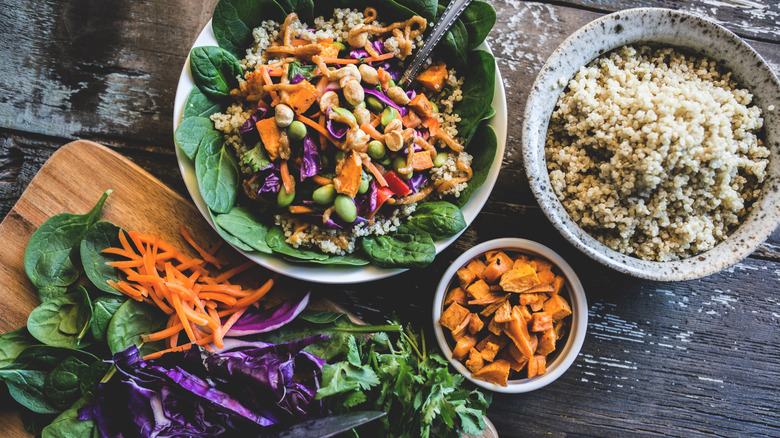The Canned Ingredient That Can Make Bland Grains Exciting
Whatever your favorite cuisine, and no matter your diet, it's always wonderful when the flavor in dishes can be amped up with little effort. With that in mind, there are lots of tricks. Cook's Illustrated offers these: a squeeze of citrus for acidity, fresh herbs (and knowing when to add them), and a bit of soy sauce or Worcestershire. Blooming ground spices in fat is another big flavor booster, as is caramelizing tomato paste until it's rounded and robust. Of course, salt is one of the best options because it won't alter flavors as it enhances them, according to Science Focus.
Adequately salting starchy and mild whole grains is crucial for a tasty savory dish. Further, layering some of the methods outlined above gives these bland flavor absorbers an excellent chance at being appreciated equally along with their usually more exciting toppings. Additionally, providing a liquid other than water can do wonders for farro, quinoa, and bulgur, among others. Per Kitchn, fruit and vegetable juices, broth, tea, beer, and finally, coconut milk, are good alternatives to water when cooking grains.
Canned coconut milk is a pantry staple for many home cooks. It's affordable, widely available, and it stores easily for long periods. But more importantly, "Coconut milk can tolerate a lot of different spices and complexities of flavor, takes acid so well, and brings up the fruity nuances of everything it's involved with," Cheetie Kumar, a chef and restaurant owner told Eater. "I can't really think of an application where I wouldn't use it."
Coconut milk adds more than coconut flavor
According to MyRecipes, coconut milk gives rice an instant upgrade; Substitute half of the water for more flavor and a creamier texture resulting in a delicious bed for a variety of curries and stews. Kitchn suggests jasmine rice and a bit of sugar for this traditional dish, called (predictably) coconut rice; Yet they say quinoa is another grain delightful when cooked this way. Alternately, in a recipe by Epicurious that uses quinoa, freekeh, or farro, the grains are first cooked in water and then simmered briefly in coconut milk with spices and aromatics, which simultaneously soaks into and sauces them.
Savory meals aren't the only place for coconut milk-fortified grains. Rather than being just a foil to vegetables and meat, it can play up the comforting spice and sweetness of breakfast and dessert foods. Oatmeal and porridges are classic representations of milk and cream-cooked grains that are readily made plant-based with a switch to coconut milk. Dole recommends amaranth for this treatment in its Blueberry Coconut Amaranth Bowl, a hearty breakfast featuring cinnamon, maple syrup, and blueberries. Per the Escoffier School of Culinary Arts, amaranth, millet, teff, buckwheat, and quinoa, are naturally gluten-free; And gluten and lactose intolerance frequently go hand-in-hand (via Beyond Celiac), therefore cooking these ancient grains in coconut milk offers a wealth of appetizing options for everyone, including those on a restricted diet.

